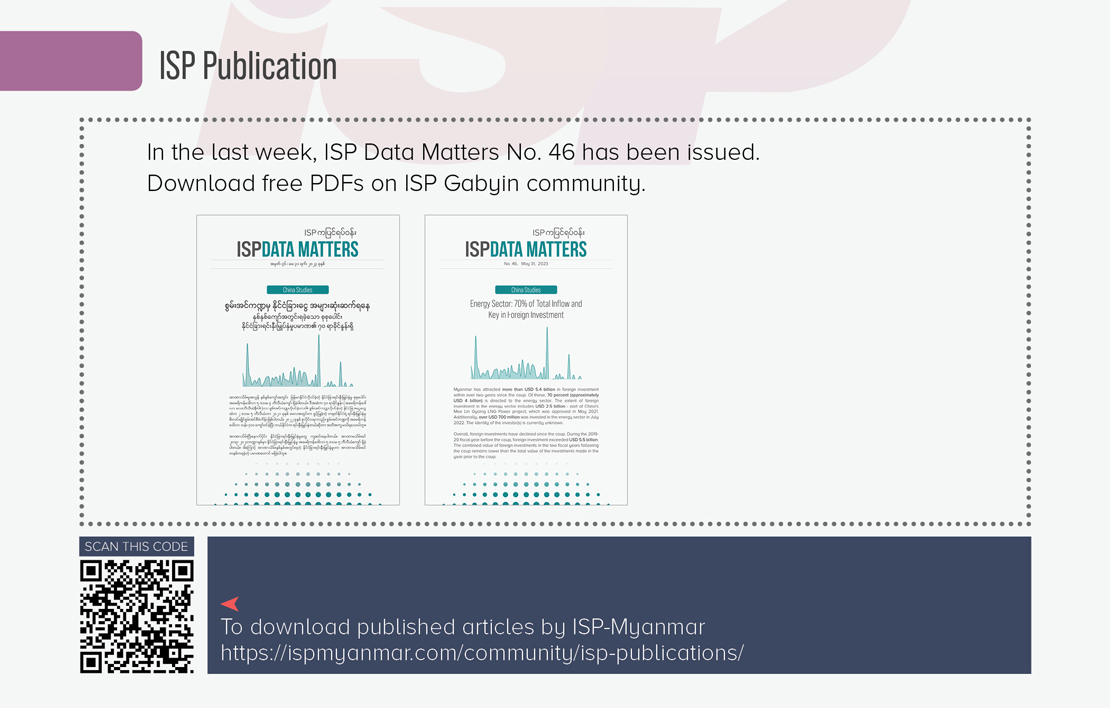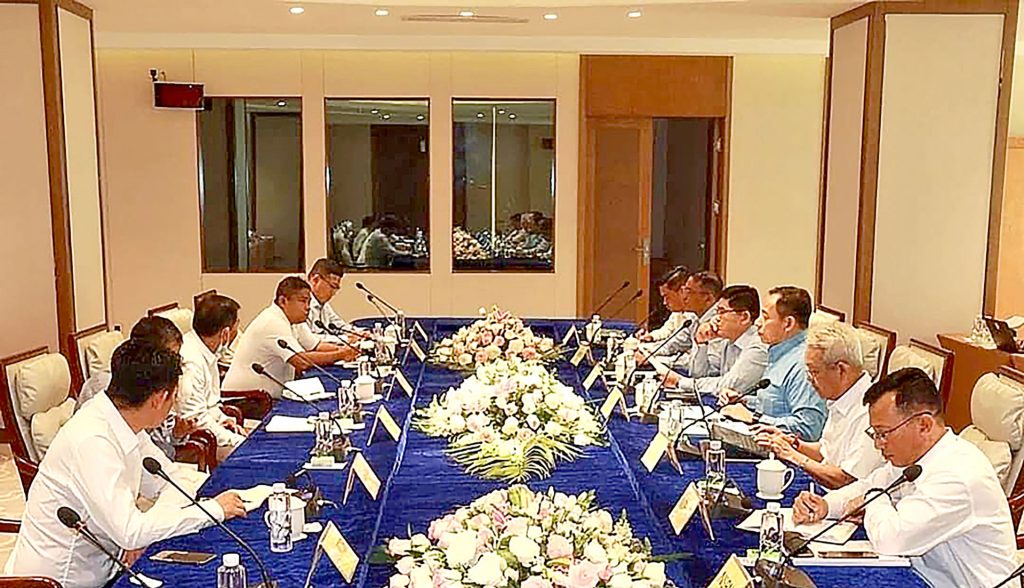Insight Email No. 16
This week’s ISP Insight email focuses on the Mongla talks between the State Administration Council (SAC) and the Three Brotherhood Alliance. In addition, it discusses the importance of the Sagaing Forum in its attempt to formulate the long-term vision, as well as medium-term and short-term preparations for their anti-coup struggle in Sagaing Region where more than 300 armed resistance forces are active. This email also explores contentious issues in the China Myanmar border trade, particularly an incident where the Chinese authorities announced an auction of agricultural products worth 30 billion Kyats confiscated from Myanmar trader. The bulletin also discusses a possible food insecurity crisis that looms over a quarter of Myanmar’s population as well as changes in the trafficking routes of illicit drugs in the East and Southeast Asia regions, as reported by UNODC.
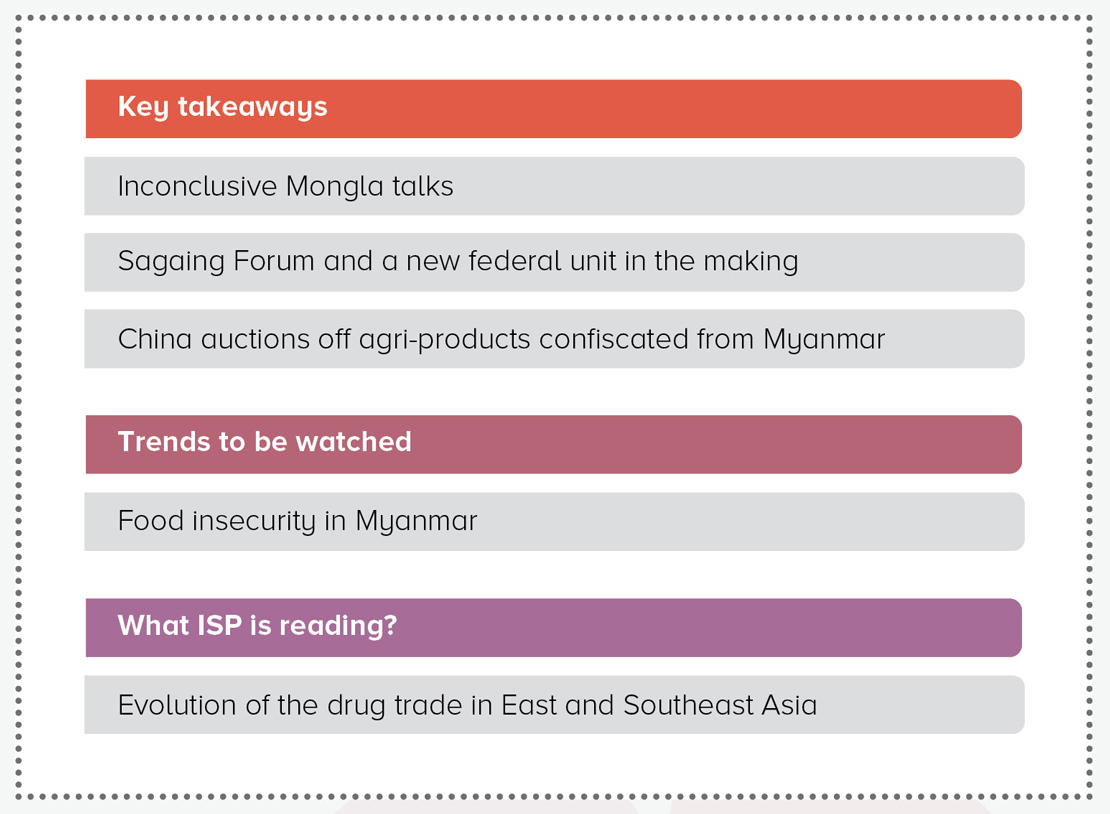
∎ Key takeaways
1. Inconclusive Mongla Talks
In early June, the State Administrative Council’s (SAC) the National Solidarity and Peacemaking Negotiation Committee (NSPNC), and delegations of the Three Brotherhood Alliance — the Arakan Army (AA), Ta’ang National Liberation Army (TNLA) and Myanmar National Democratic Alliance Army (MNDAA) — met in Mongla of Shan State (East). While the SAC presented the gathering as a ‘Peace Talk’ in its official news, sources indicate that the discussions were facilitated by officials from China.
Following the military coup in Myanmar, there have been informal, virtual discussions between AA, TNLA, MNDAA and the SAC. However, the latest dialogue was a formally organized event. The National Democratic Alliance Army (NDAA), an ally of the Three Brotherhood Alliance, sponsored the meeting. A special envoy from Yunnan province’s Foreign Affairs Department, Mr. Guo Bao participated in the meeting.
The meeting, initially scheduled for three days, concluded in just two days. During the discussions, the participating parties presented their respective points and demands, maintaining a seemingly cordial atmosphere and avoiding confrontation. The SAC’s NSPNC raised three issues; namely the consolidation of multi-party democracy, the building of a federal democratic union, and trust-building measures for peace and development works. The delegations of the Three Brotherhood Alliance similarly expressed three demands; the release of arrested group members, to be delisted as illegal organizations, and for timely relief and humanitarian assistance to be provided to cyclone victims in Rakhine State.
The delegations of the Three Brotherhood Alliance did not immediately respond to the political proposal put forth by the SAC, which resulted in the early conclusion of the meeting. They typically align themselves with the political dialogue and policies of the Federal Political Negotiation and Consultative Committee (FPNCC), which includes the United Wa State Party (UWSP) and the Kachin Independence Organization (KIO). As a result, they exercise caution when engaging in new political positions, ensuring that their stance remains consistent with the policies set forth by the FPNCC.
The SAC has already responded to the demands of the Three Brotherhood Alliance. Sources have reported that the SAC intends to provide further clarification on details on negotiating points emerging from its internal discussions, and will inform the discussion points from the SAC’s previous meeting with the UWSP, and NDAA. The SAC delegation has displayed an eagerness to engage in further rounds of talks with the Three Brotherhood Alliance. Depending on progress and developments, there is a possibility that the next meeting could take place in Naypyitaw.
While the Mongla talk was taking place, there were reports of intense clashes between the SAC’s forces and the MNDAA. The MNDAA stated that these clashes were initiated by the SAC as part of their offensive operations Brigade 611 of the MNDAA, which is particularly comprised of young activists from the Spring Revolution, also participated in these clashes. The MNDAA recently established, armed and trained this separate Bridgade 611 with young Bamar activists. (See ISP Explainer No. 1)
In Rakhine State, both the AA and the SAC have been separately involved in efforts to provide rehabilitation and relief to victims of the Mocha cyclone. However, as yet the two parties have not established any official collaboration for humanitarian work. Meanwhile, SAC restrictions at some checkpoints could hinder access to effective and timely assistance. There is a chance that these restrictions may be eased following the recent talks.
While it is possible that Chinese mediation could facilitate a meeting between the SAC and the Three Brotherhood Alliance, so far no significant political progress has been achieved. However, both parties have managed to avoid adopting a confrontational approach during talks. It remains too early to assess the progress of the negotiations. But as ISP-Myanmar has previously discussed, the ‘China Grand Opening’ could incentivize the empowerment of local interest groups, giving rise to a relapse of the ‘Ceasefire Crony Capitalism’ of the 1990s.
On the one hand, the combination of brutal oppression and the adverse effects of climate change could push Myanmar society into a downward spiral, leading to a humanitarian crisis. In such a scenario, the Ethnic Armed Organizations (EAOs) may prioritize their own survival and long-term agendas and could seek a truce with the junta, either for temporary relief or a longer-term truce, led by vested interests, which could develop towards a ‘negative peace’, comprising merely an absence of violence, but without any significant political solution. However, if the EAOs were to continue to aim high and collaborate amongst themselves in order to establish more favorable political alternatives, then inclusive political dialogue and meaningful change could become a viable alternative for Myanmar’s future.
As discussed in ISP OnPoint No. 15, Myanmar’s conflict could become more complicated than simply carrying on the fight against the military junta. The consequences of climate change could generate new forms of conflict. In such a scenario, the whole of Myanmar society could become caught in a prolonged and repetitious ‘conflict trap’.
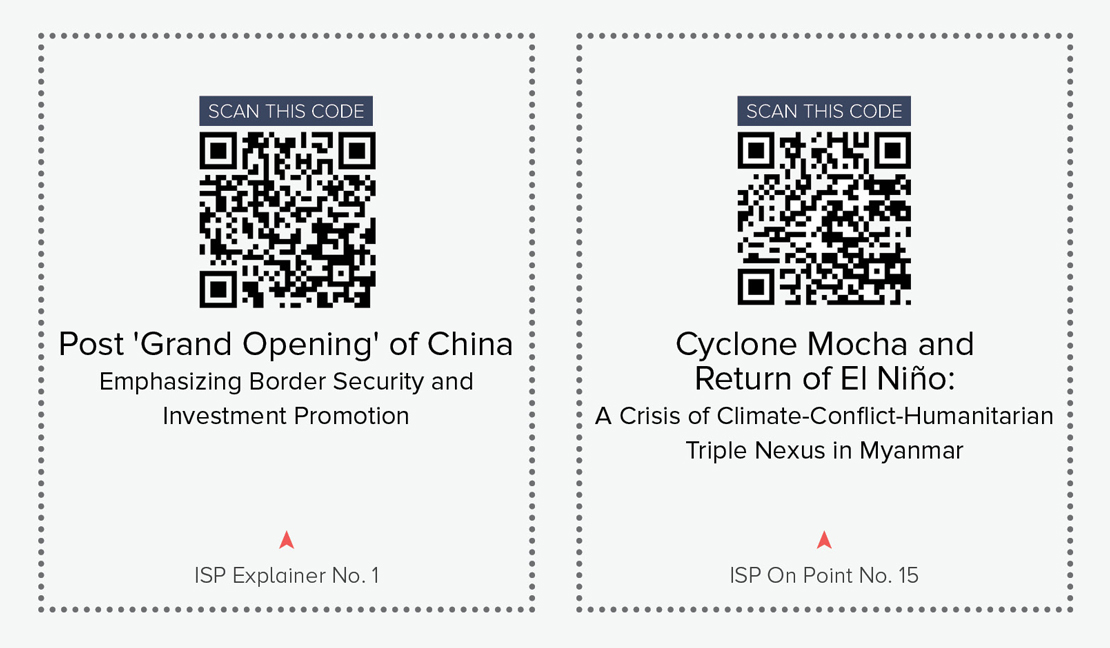
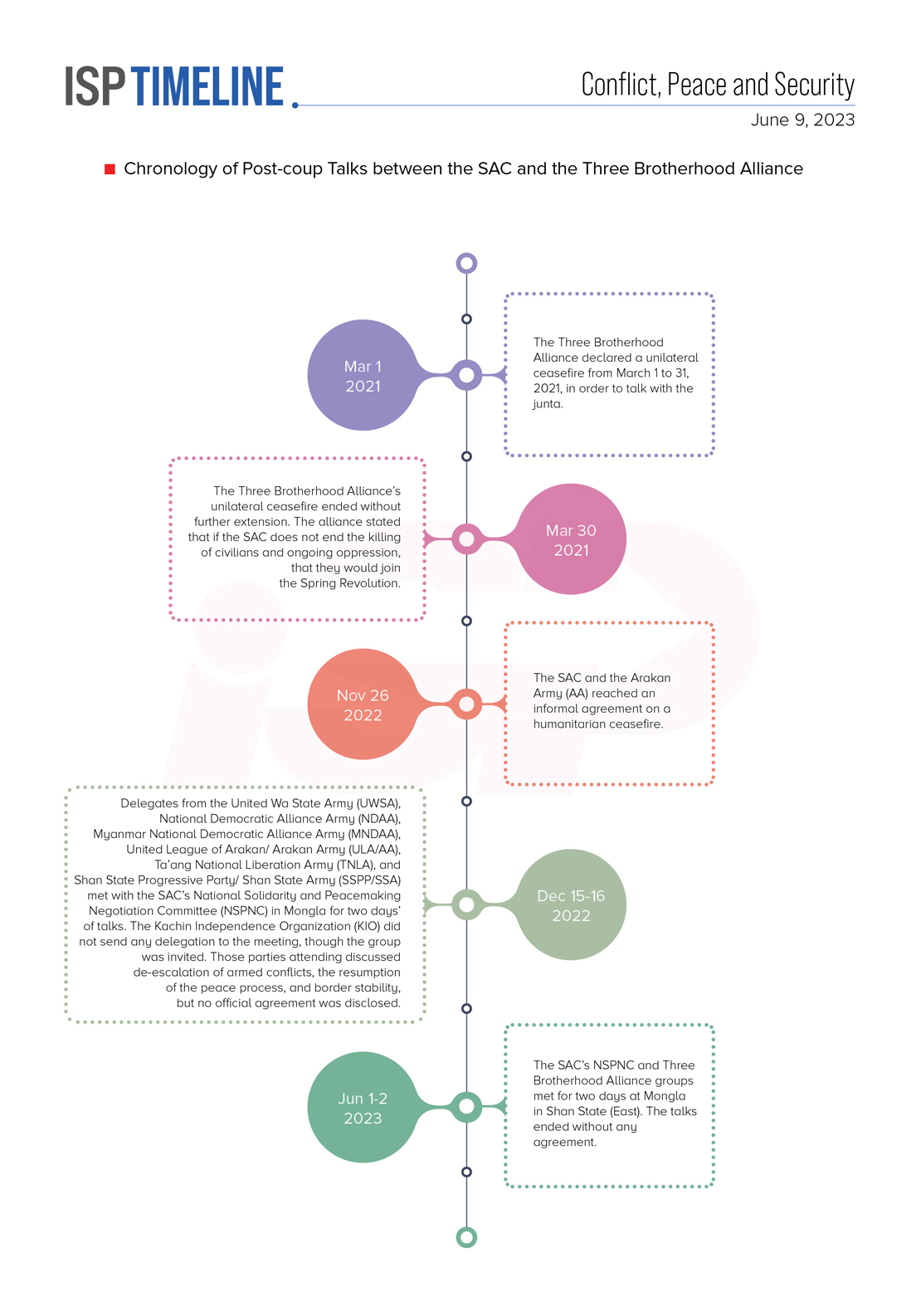
2. Sagaing Forum and a new federal unit in the making
The first ‘Sagaing Forum’, an event orchestrated by 30 armed groups from Sagaing Region, was held on May 30-31, 2023. 173 resistance groups from Sagaing Region and 31 observers reportedly attended the forum, including some local administration units and Civil Disobedience Movement (CDM) organizations.
The Sagaing Region has emerged as a strong and resilient center within the anti-coup ‘Spring Revolution’ movement, along with other fervent anti-SAC regions within the dry zone. There are approximately 300 armed forces of various sizes fighting against the central government in the Sagaing Region, including NUG’s troops under the Northern Command and Western Command. In addition, there are 41 local defense forces working under NUG leadership.
Due to the emergence of numerous resistance forces in the Sagaing Region, it has become the regions with the second-highest number of clashes in Myanmar. The SAC military’s brutal offensives have resulted in widespread displacement and severe human rights abuses. Many villages in the region have been completely burned down as a consequence of the conflict. Sagaing Region accounts for 71 percent of the total number of villages that have been burned down during the course of the conflict, and approximately half of the total displaced people in the country currently reside in Sagaing Region.
According to sources, the first Sagaing Forum was organized and conducted through discussions in four key chapters: politics, military, local governance, and a ‘general’ chapter. The political significance of the Sagaing Forum lies in the participants’ long-term vision of the Sagaing Region becoming a future federal unit of the Union of Myanmar. For the medium-term, the Forum aims to form a ‘consultative council’, which would work towards the emergence of a ‘federal unit’ in the future. In the short-term, the Forum seeks better cooperation and collaboration of political and military functions among its constituent forces, including local defense forces, for better check-and balance.
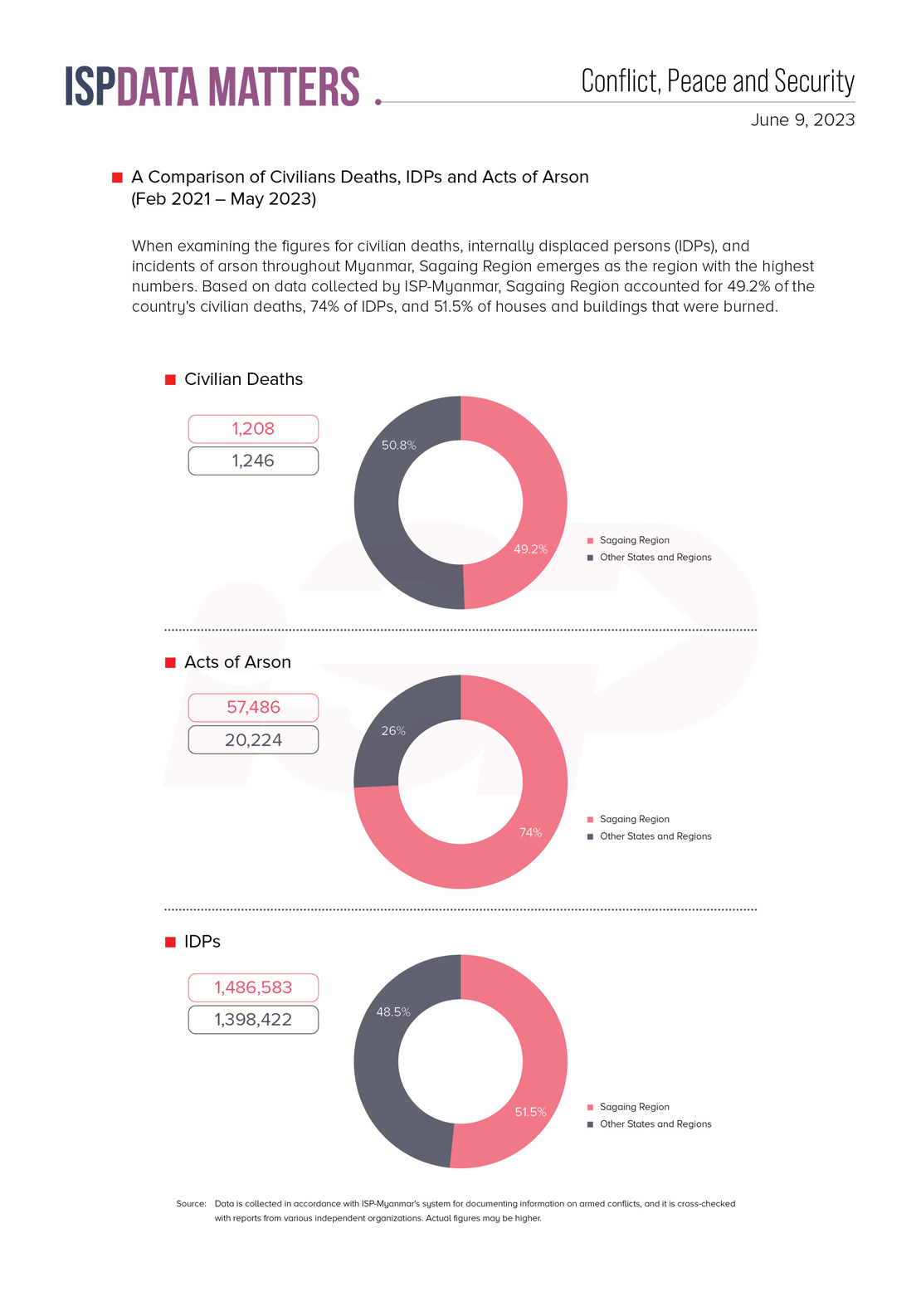
While there are claims suggesting that the Sagaing Forum aims to rival the power and influence of the National Unity Government (NUG) in an attempt to free itself from NUG control, the organizers of the forum have denied such assertions. The significance of the Sagaing Forum lies in its organic development within the Bamar-based dry zone resistance forces. It could potentially serve as a model for collaboration in other regions. However, it is still too early to analyze the ultimate outcomes and lasting repurcissions of the Sagaing Forum. What sets the Sagaing Forum apart is its distinct format, which represents a bottom-up approach. The forum emphasizes allinclusiveness, collective decision-making, and the representation of local voices. This approach can be seen as a potential positive beginning for establishing a new tradition that values the participation and perspectives of various stakeholders.

3. China auctions Myanmar’s confiscated agri-products
Chinese authorities have announced their plans to conduct an auction of agricultural products previously confiscated from Myanmar trader, with a total estimated value of 30 billion Kyats (around 14.35 million USD). Last April, Chinese customs officials from Ruili confiscated various types of agricultural product including sesame, turmeric roots, and indigenous medicines which had been kept in warehouses in border area in China. The goods will reportedly be transported to restricted areas within China. Two Myanmar merchants were also arrested in connected with the incident. Chinese authorities have declared that the auction is to be held on May 31. In response to this development, Myanmar traders held a press conference and appealed to the State Administrative Council (SAC) for assistance in resolving the situation.
Of the confiscated goods, pulses, sesame, and maize would have been allowed to be traded within Yunnan province. But these goods were intended to be transported to Guangzhou, Fujian, and Sichuan provinces bypassing Yunnan province. For this reason, the Chinese authorities confiscated the goods. Chinese authorities announced on June 6 that these confiscated goods will be auctioned for a total value of 30 billion Kyats (approximately 14.35 million USD or 100 million Chinese RMB).
The confiscated products were exported from Myanmar in December 2022 at the time of the Wanding – Pang Hseng border gate closure due to the Covid-19 pandemic. Myanmar traders had stored the goods in warehouses in Wanding. Sources report that customs duties were paid to both the authorities of China and Myanmar, and that the trade had had the full support of official documents, and had been transported by conventional routes. Previously, Myanmar products had been traded through the ‘105 Mile Border Trade Zone’, however due to the Covid-19 restrictions, the products were first stored in Wanding and later processed as exports to Chinese traders. Myanmar traders have complained that they were not aware of any policy changes in China.
Officials from the SAC Ministry of Commerce are currently in dialogue with China’s ambassador to Myanmar and with their Chinese counterparts in Kunming, Yunnan province regarding trading difficulties and financial losses experienced as a result of the failed trades. Previous experience has shown that Myanmar traders have frequently faced difficulties in trading with China including opening themselves to property losses by arbitrary policy changes and in one instance, Myanmar traders had their bank accounts frozen. The timing of the agricultural auction incident coincides with China’s promotion of bilateral trade under the ‘China Grand Opening’ policy. If Myanmar small traders were to suffer significant losses in their investments, it would be challenging for them to recover, which could have a detrimental impact on the resumption of border trade. In a recent trade fair held between China (Lancang) and Myanmar (Naypyitaw), the SAC made a request to China to relax restrictions on Myanmar’s exports.
∎ Trends to be watched
Food insecurity in Myanmar
The Food and Agriculture Organization (FAO) and the World Food Programme (WFP) has projected that 15.2 million people in Myanmar (more than a quarter of the nation’s population) are at risk of acute food insecurity in the period June through November 2023. The reasons are the combined impact of ongoing conflicts, economic uncertainty, lack of humanitarian access, displacement, and high food prices. The report warns that acute food security is likely to deteriorate in 18 hunger hotspots over the next several months.
A report from the United Nations Development Program (UNDP)’s targeted survey also warns of increasing ‘overall vulnerability’ in Myanmar, due to falling income, depletion of assets, lack of access to healthcare and nutrition, disruption of education, and rising conflict-related insecurity. When household incomes decrease, families normally have to deploy a variety of coping strategies (such as the use of savings, borrowing from friends and family, and in more severe cases, selling off productive assets, reducing intake of nutritious food, or withdrawing children from school). In mid-2021, 26.5% of households had sold assets, rising to 42% by mid-2022. UNDP stresses that Myanmar children are stuck in a poverty trap.
According to SAC data, there are 15 million acres of monsoon paddy and 2.42 million acres of summer paddy currently cultivated in Myanmar. In the 2021-22 financial year, the country produced 1.315 billion baskets of paddy rice, which made it not only adequate for local consumption but also contributed to exports. Myanmar exported 1.8 million metric tons of rice in the 2020-21 financial year and 1.3 million tons in the 2021-22 Mini Budget year. The private sector also confirms that Myanmar still has adequate rice supply, but that output has nonetheless decreased due to climate and conflict-induced problems. But in the near future it remains important to monitor whether agricultural supplies encounter logistics challenges and other obstacles in reaching consumers.
∎ What ISP is reading?
Evolution of the drug trade in East and Southeast Asia
UNODC. (2023). Synthetic Drugs in East and Southeast Asia: Latest Developments and Challenges. Bangkok: Regional Office for Southeast Asia and the Pacific, UN. (130 pages)
United Nations Office of Drug Control and Crimes (UNODC)’s Regional Office for Southeast Asia and the Pacific recently published a report. Although Myanmar is not the specific focus, it remains at the epicenter of the reporting. The report discusses the latest trends in illicit synthetic drug production, trade and dissemination in East and Southeast Asia. Despite regional governments’ efforts to crack down on the illicit business in 2022, the report details chapters which explore the latest developments in methamphetamines, ketamine, ecstasy, and other new forms of synthetic drugs. The report takes a country-specific approach, focusing on developments in Brunei, Cambodia, China, Indonesia, Japan, Laos, Malaysia, Myanmar, the Philippines, South Korea, Singapore, Thailand, and Vietnam.
The report warns of the changing patterns of synthetic drug production and trafficking routes in East and Southeast Asia. “Transnational organized crime groups anticipate, adapt and try to circumvent what governments do” remarked Jeremy Douglas, UNODC Regional Representative for Southeast Asia and the Pacific at the report launch. “Traffickers have continued to ship large volumes through Laos and northern Thailand, but at the same time, they have pushed significant supply through central Myanmar to the Andaman Sea where it seems few were looking” he added.
Myanmar production still dominates the methamphetamine market, especially in Shan State which is the epicenter of production. The report mentions the continued ‘spillover’ of methamphetamine produced in Myanmar which impacts countries across not only East and Southeast Asia, but also Oceania, increasingly South Asia, particularly Bangladesh and, more recently, northeast India. In 2022, Myanmar authorities seized a record amount of over 23.4 tons of crystal methamphetamine, a nationwide increase of over ten tons. But regional patterns of crystal methamphetamine seizures were noticeably changing, with seizures of the drug in Shan State decreasing from 7.4 tons to 5.3 tons, while there were more seizures in Mandalay and Mon states.
“Supply within central Myanmar itself significantly expanded, and traffickers quietly started moving product to the coastlines … on the Andaman Sea,” Douglas said on the report launch. “In other words, the most powerful regional trafficking networks are able to operate with a high degree of certainty they can and will not be stopped, … they are able to dictate the terms and conditions of the market as a result,” he added. Methamphetamine products are still available on the streets, with prices now lower than in 2022, suggesting increased supply. The drugs certainly still flow despite any government barriers. A separate SAC report mentioned that in 2022, Myanmar authorities recorded 6,276 cases of drug-seizures, totaling 1,069.94 billion Kyats (approx. 509. 49 million USD) in value. Seizures included 2.04 tons of ketamine.
“The discovery of a series of industrial-scale clandestine ketamine laboratories, processing warehouses, and storage facilities across the country has set off alarm bells in the region and with international partners,” Douglas warned.
